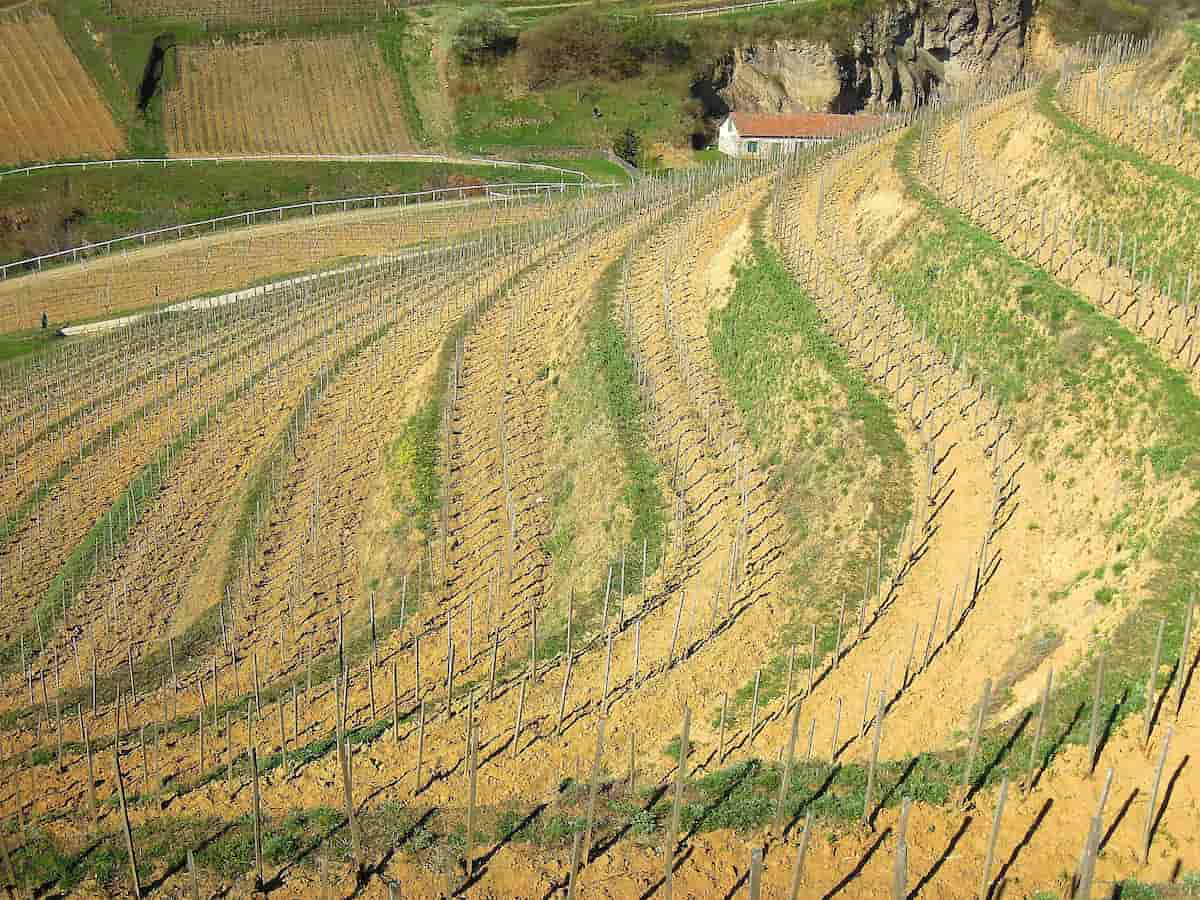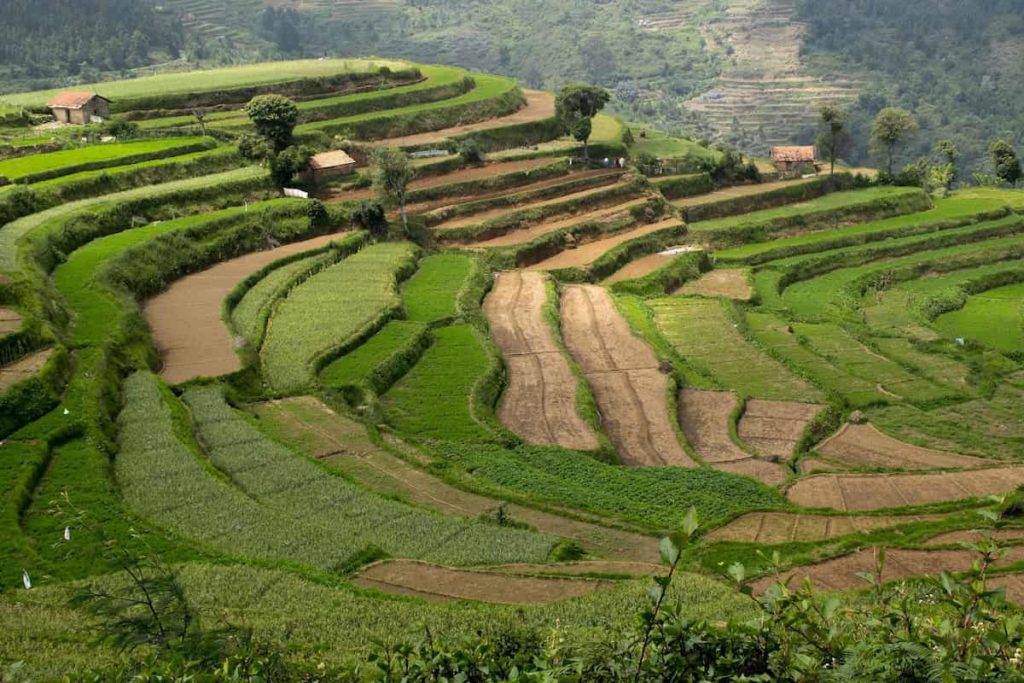Wheat is a staple crop that requires specific soil management and fertilization practices to achieve ...
Contour Farming is a very common farming technique practiced in India. It is commonly practiced in hilly regions having bund or ridges. It helps to promote crop yield and reduces soil erosion. In this blog, we will understand the brief context of contour farming in India. Contour farming is the method of planting crops along a contour that is basically across the slope (horizontal) rather than up and down (vertical).
कॉन्टूर खेती एक बहुत सामान्य कृषि तकनीक है जो भारत में प्रचलित है। यह पहाड़ी क्षेत्रों में आमतौर पर की जाती है जहां पर बाँध या कच्ची दीवारें होती हैं। यह फसल उत्पादन को बढ़ाने में मदद करती है और मिट्टी के कटाव को कम करती है। इस ब्लॉग में, हम भारत में कॉन्टूर खेती के संक्षिप्त संदर्भ को समझेंगे। कॉन्टूर खेती का मतलब है फसलों को ऐसी रेखाओं के साथ लगाना जो ढलान के पार होती हैं, बजाय ऊपर-नीचे करने के। खुदाई को ढलान के समांतर न होकर लम्बवत तरीके से जुताई की जाती है।
कॉन्टूर खेती के कई लाभ हैं। इनमें शामिल हैं:

कॉन्टूर खेती के लिए भूमि तैयार करना एक महत्वपूर्ण कदम है क्योंकि पानी का प्रवाह आपकी फसलों को नुकसान पहुंचा सकता है। कंटूर ढलान पानी के प्रवाह को तेज करते हैं, और बहते हुए पानी की गति मिट्टी को धो सकती है, जिसके परिणामस्वरूप फसलों को नुकसान होता है।कंटूर खेती के लिए भूमि तैयार करने के लिए निम्नलिखित चरणों का पालन करें:
1. क्षेत्र का शीर्षोग्राफिक सर्वेक्षण ध्यान से करें।
2. कृषि उपकरण और मशीनरी के उचित आंदोलन के लिए खेत की सीमाएँ बनाएं।
3. खेती के कार्यों को कंटूर बेसलाइन के समानांतर करें।

सीमित अनुप्रयोगिता- कंटूर खेती केवल उन ढलान वाले क्षेत्रों के लिए उपयुक्त है जिनका झुकाव 2% से 10% के बीच है। समतल या अत्यधिक ढलान वाले क्षेत्र कंटूर खेती के लिए व्यावहारिक या प्रभावी नहीं हो सकते हैं।
श्रमिक-गहन कार्यान्वयन- कंटूर रेखाओं और ढलानों के कारण, इसमें सामान्य से अधिक समय लगता है इसलिए यह एक श्रमिक-गहन कार्यान्वयन विधि है।
सीमित फसल विकल्प- ढलान वाले खेत के क्षेत्र के कारण हमेशा फसल विकल्पों की एक सीमा होती है। इसलिए, यह विधि उन फसलों की विविधता को सीमित करती है जिन्हें किसान उगा सकते हैं।
रखरखाव की आवश्यकताएँ- कंटूर पंक्तियाँ, टेरेस और संरचनाओं को प्रभावी कटाव नियंत्रण सुनिश्चित करने के लिए नियमित रखरखाव की आवश्यकता होती है। यह रखरखाव किसानों के लिए मांगलिक और समय लेने वाला हो सकता है।
प्रारंभिक निवेश- इस विधि के लिए भारी प्रारंभिक निवेश की आवश्यकता होती है, जो छोटे किसानों के लिए एक वित्तीय बोझ बन जाती है।
कंटूर कृषि भारत में एक कुशल और किफायती कृषि विधि है, जो मिट्टी की नमी को बनाए रखने में मदद करती है और विशाल उत्पादन और मिट्टी के संरक्षण का उत्पादन देती है। इसलिए, यह एक सतत विधि है जो मिट्टी के कटाव को 50% तक कम करती है।
यह भी देखे -
Youtube video 📷- कंटूर फार्मिंग की पूरी जानकारी
Contour farming offers several benefits, including:
Preparing the land for contour farming is a crucial step as water flow can damage your crops. Contour slopes speed up water flow, and the velocity of running water can wash away soil, resulting in crop damage. Follow these steps to prepare the land:
1. Conduct a careful topographic survey of the area.
2. Create field boundaries to allow proper movement of agricultural tools and machinery.
3. Perform farming activities parallel to the contour baseline.
Limited Applicability – Contour farming is suitable only for sloped areas with a gradient between 2% and 10%. Flat or steeply sloped lands may not be practical or effective for this method.
Labor-Intensive Implementation – Due to contour lines and slopes, it takes more time than usual, making it a labor-intensive farming method.
Limited Crop Options – The sloped land restricts the variety of crops that can be grown, thus limiting crop diversity.
Maintenance Requirements – Contour rows, terraces, and structures require regular maintenance to ensure effective erosion control, which can be time-consuming and demanding for farmers.
Initial Investment – This method requires heavy initial investment, which can become a financial burden for small-scale farmers.
Contour farming is an efficient and cost-effective method in India that helps retain soil moisture and enhances both productivity and soil conservation. It is a sustainable practice that reduces soil erosion by up to 50%.
0
0
Wheat is a staple crop that requires specific soil management and fertilization practices to achieve ...
भारत में कृषि न केवल एक प्रमुख आर्थिक � ...
Neem cake is an organic byproduct derived from cold-pressed neem seeds after the extraction of neem ...
खरीफ फसलें-मानसून के मौसम में उगाई जात ...
Rice farming requires careful management of soil nutrients to ensure optimal growth and yield. The a ...
Fertilizers are essential substances used in agriculture to enhance the growth and productivity of c ...
Mango farming is a significant agricultural practice in many tropical and subtropical regions. Known ...
Organic farming is an agricultural practice that focuses on growing crops and raising livestock in a ...
Crop rotation, a key agricultural practice, involves growing different crops in the same field acros ...
Soil fertility is crucial for any farmer or gardening enthusiast. Fertile soil promotes healthy plan ...
Soil testing is a process that provides farmers with crucial information about the quality, nutrient ...
The tradition of farming in India is centuries old, and wheat and barley hold significant importance ...
The Aak plant (Calotropis gigantea) is a remarkable creation of nature, valued for its distinctive f ...
Roses, known for their beauty and enchanting fragrance, are the pride of every garden. However, main ...
Agricultural Pollution refers to the harmful effects caused by agricultural activities on the enviro ...
Temperature fluctuations have a direct impact on wheat farming. It affects sowing, growth, grain for ...
During summer, rising temperatures increase the risk of fire in wheat crops. As April begins, wheat ...
Agroforestry is a term derived from two words: "Agriculture" and "Forestry." It is a land-use system ...
कृषि में आर्टिफिशियल इंटेलिजेंस (AI) क ...
Vegetables to Sow in May : Dear farmer friends, in the month of May, our plants don't usually suff ...
Papaya is a highly nutritious fruit loaded with medicinal properties. Its consumption helps regula ...
India is an agrarian country with three major agricultural seasons and a variety of crops being prod ...
Leaf curl disease, which causes leaves to curl, is a serious threat to agriculture. This disease aff ...
Intercropping is a farming method where two or more crops are grown together in the same field. It h ...
Mulching is a layer spread over the surface of the soil, primarily aimed at retaining soil moistur ...
India is an agriculture-based country, yet many farmers can’t use their land as it remains barren ...